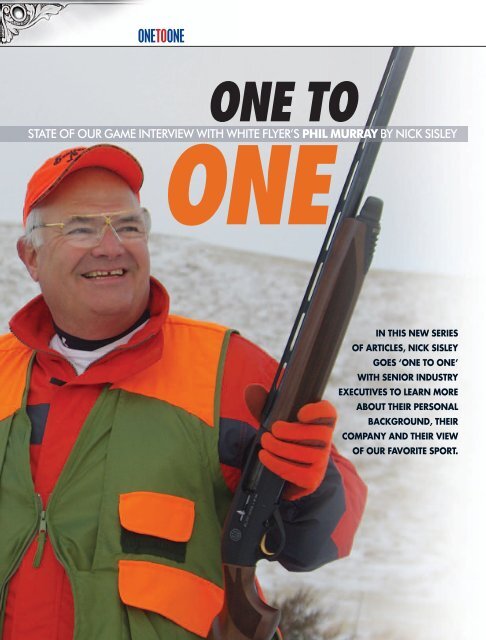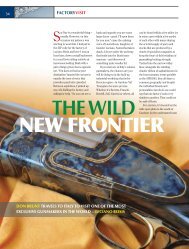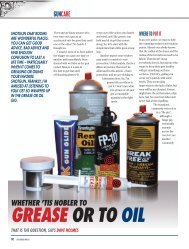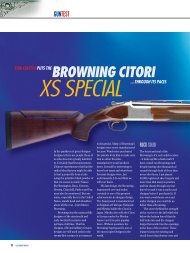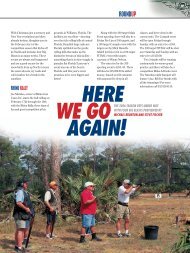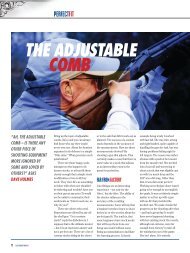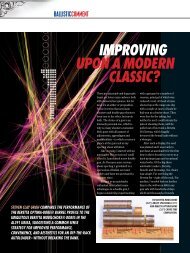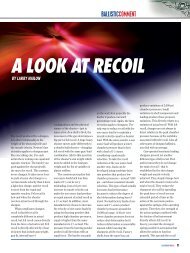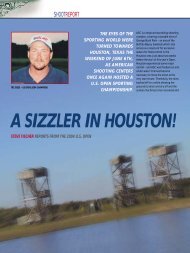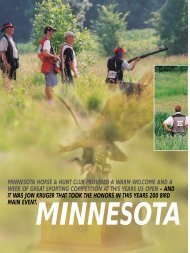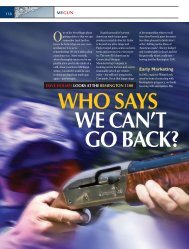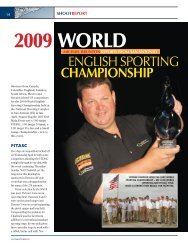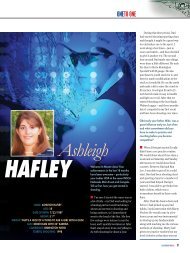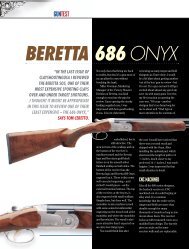one to one:Layout 1 - Clay Shooting USA
one to one:Layout 1 - Clay Shooting USA
one to one:Layout 1 - Clay Shooting USA
You also want an ePaper? Increase the reach of your titles
YUMPU automatically turns print PDFs into web optimized ePapers that Google loves.
ONETOONE<br />
ONE TO<br />
STATE OF OUR GAME INTERVIEW WITH WHITE FLYER’S PHIL MURRAY BY NICK SISLEY<br />
ONE<br />
IN THIS NEW SERIES<br />
OF ARTICLES, NICK SISLEY<br />
GOES ‘ONE TO ONE’<br />
WITH SENIOR INDUSTRY<br />
EXECUTIVES TO LEARN MORE<br />
ABOUT THEIR PERSONAL<br />
BACKGROUND, THEIR<br />
COMPANY AND THEIR VIEW<br />
OF OUR FAVORITE SPORT.
ONETOONE<br />
Phil Murray’s life has been almost<br />
fairy tale in nature – certainly from<br />
a shooter’s standpoint. Born in San<br />
Francisco in 1949, he started<br />
hunting with his Dad at the tender<br />
age of nine – though he was not<br />
allowed <strong>to</strong> carry a gun until several<br />
years later. They did a lot of<br />
hunting <strong>to</strong>gether back in those<br />
days – ducks, doves and deer.<br />
Graduating from High School<br />
in San Mateo, California in 1972,<br />
Murray went on <strong>to</strong> graduate from<br />
San Jose State University in 1976.<br />
But even in High School he had<br />
become an accomplished clay<br />
target shooter, making the<br />
National Skeet <strong>Shooting</strong><br />
Association’s All-America Team for<br />
his first time as a Junior. During<br />
his freshman year the great D. Lee<br />
Braun had seen him shoot and<br />
asked his father if he might give<br />
the youngster some instruction –<br />
and that was the start down his<br />
road <strong>to</strong> shotgunning expertise.<br />
HAVE FUN<br />
I asked Murray about some of the<br />
things that Braun had instilled in<br />
him during those early days.<br />
“Shoot <strong>one</strong> target at a time – taking<br />
each shot <strong>to</strong> a more intense level.<br />
Shoot every shot like it’s the very<br />
last target you are ever going <strong>to</strong><br />
shoot in your life,” recalls Murray.<br />
“But more importantly, Lee was<br />
always preaching that the game<br />
was supposed <strong>to</strong> be fun. Frankly, I<br />
hear that phrase, or something like<br />
it, often – but only recently has this<br />
instructive phrase started <strong>to</strong> sink in<br />
with me,” continued Murray. “What<br />
it really means is allowing your<br />
subconscious mind <strong>to</strong> take over –<br />
putting your conscious mind on the<br />
back burner while you are on the<br />
station. If you stay happy, stay<br />
positive, enjoy the game, view<br />
missing as something <strong>to</strong> learn from<br />
– you’re on the right track. If you<br />
think negatively in any way about<br />
missing, you’ll shoot worse – and<br />
certainly won’t be having any fun.”<br />
But Braun wasn’t Murray’s<br />
only outstanding men<strong>to</strong>r. The<br />
other was his shooting idol – Bill<br />
Rogers, inducted in<strong>to</strong> the Skeet<br />
<strong>Shooting</strong> Hall of Fame in the<br />
1960s. Rogers was there when any<br />
youngster asked for help – he had<br />
nearly 15 kids under his shooting<br />
wing during Murray’s formative<br />
years, and, notably, they all<br />
became All-Americans.<br />
GOLDEN AGE<br />
Murray <strong>to</strong>ld me that he thought<br />
the late 1950s and the early 1960s<br />
was the golden age of competitive<br />
PHIL MURRAY WITH HIS DAD BACK IN 1965.<br />
shotgunning, where every<strong>one</strong><br />
pulled for <strong>one</strong> another – maybe<br />
even more so than <strong>to</strong>day – though<br />
that attitude <strong>to</strong>ok nothing away<br />
from the competitive drive among<br />
the individuals. “But then along<br />
came Purbaugh sub-gauge tubes,”<br />
said Murray. “Yellow targets were<br />
switched <strong>to</strong> orange. Scores started<br />
going up and Kenny Barnes<br />
showed us all what was possible<br />
with his first ever 400 straight.”<br />
(Ed: Murray was on that same<br />
squad when Barnes shot that first<br />
400 straight with a pump gun.)<br />
Murray then taught school for<br />
four and a half years – ideal in that<br />
he had the summers off <strong>to</strong> shoot!<br />
Then, from 1969 – 1977, he was<br />
Edi<strong>to</strong>r and Publisher of a magazine<br />
devoted <strong>to</strong> clay target shooting in<br />
the western <strong>USA</strong> – The Skeeter.<br />
From 1977 – 1984 he was hired as<br />
Deputy Direc<strong>to</strong>r of the National<br />
Skeet <strong>Shooting</strong> Association under<br />
Direc<strong>to</strong>r Ann Myers – but still had<br />
time in 1983 <strong>to</strong> shoot 650 straight<br />
at the World Skeet <strong>Shooting</strong><br />
Championships.<br />
“I’ve been lucky <strong>to</strong> shoot with<br />
some great squad members – like<br />
Kenny Barnes, Robert Pax<strong>to</strong>n,<br />
Ricky Pope and many others,” said<br />
Murray. “<strong>Shooting</strong> with the best<br />
can’t help but make any<strong>one</strong> a<br />
better shooter.” These days he<br />
shoots a lot with John Imbt, Ellen<br />
Nelms, Gayle Osborne and other<br />
<strong>to</strong>p shots – most of them Hall of<br />
Fame inductees. “All of Lee<br />
Braun’s students, once he was not<br />
able <strong>to</strong> shoot anymore, would<br />
receive a telegram when the World<br />
Skeet Championships started,<br />
encouraging them <strong>to</strong> do well. What<br />
a beautiful <strong>to</strong>uch from a true class<br />
gentleman,” Murray <strong>to</strong>ld me.<br />
PHIL MURRAY (FAR RIGHT) AS<br />
A 15 YEAR OLD – ALREADY AN<br />
ACCOMPLISHED SHOT.<br />
CLAYSHOOTING<strong>USA</strong> 75
ONETOONE<br />
NEXT STOP<br />
In 1984 Murray went <strong>to</strong> work for<br />
Beretta in Maryland – as the Club<br />
Manager at the Prince Georges<br />
County Gun Club and the<br />
company’s <strong>Shooting</strong> Promotions<br />
Manager. “During those years I<br />
really built up my shooter’s<br />
knowledge, learning how <strong>to</strong> run a<br />
gun club and learning more about<br />
handling people well. That was<br />
also the year that the gun club<br />
(Beretta leased the club during<br />
those years) built the first sporting<br />
clays course. It was still called<br />
‘hunter’s clays’ back then. Beretta<br />
also put in a full International Trap<br />
layout. I think it was the first <strong>one</strong> in<br />
the eastern <strong>USA</strong>.<br />
“This is also when I was<br />
awakened <strong>to</strong> the fact that if folks<br />
came out <strong>to</strong> shoot sporting clays,<br />
and received some instruction,<br />
they would come back <strong>to</strong> shoot<br />
again,” continued Murray. “This<br />
was also at a time when Beretta<br />
was very active in trying <strong>to</strong> get<br />
their shotguns in<strong>to</strong> shooter’s<br />
hands – showing potential<br />
shooters that, yes, this<br />
shotgunning game was great fun.”<br />
Around 1992 Murray left<br />
Beretta for yet another great job<br />
within the industry – <strong>to</strong> work for<br />
Don Mainland at Kolar. He was the<br />
shooting promotions guy at Kolar<br />
at a time when they were in the<br />
final stages of the Kolar gun<br />
development – yet another great<br />
learning experience. After two and<br />
a half years with Kolar, Reagent<br />
Chemical’s Brian Skeuse offered<br />
him an opportunity <strong>to</strong> join their<br />
White Flyer clay target business –<br />
and a move back <strong>to</strong> a warm climate<br />
(Hous<strong>to</strong>n, Texas). Murray has now<br />
been with White Flyer for 11 years.<br />
CURRENT MARKETS<br />
In 1995 Murray was inducted in<strong>to</strong><br />
the National Skeet <strong>Shooting</strong> Hall of<br />
Fame – having won numerous<br />
World, State, Z<strong>one</strong> and local<br />
championships. With this in mind,<br />
I asked him what he thought about<br />
the current state of affairs in clay<br />
target shooting? “Luckily, sporting<br />
clays came along at the right time.<br />
I really believe that sporting<br />
probably saved the clay target<br />
industry. At the National Sporting<br />
<strong>Clay</strong>s Championships this year we<br />
had 1400 competi<strong>to</strong>rs – a record.<br />
In comparison, the numbers at the<br />
World Skeet <strong>Shooting</strong><br />
Championships were way down.<br />
Dit<strong>to</strong> for trap’s Grand American,<br />
now switched <strong>to</strong> Sparta, Illinois<br />
from Vandalia, Ohio.<br />
“I think sporting clays offers<br />
something different – and that’s<br />
had a lot <strong>to</strong> do with its success. But<br />
now, some course setters have<br />
started making targets much more<br />
difficult for the average competi<strong>to</strong>r.<br />
Course owners have <strong>to</strong> realize, and<br />
many of them already do, that<br />
shooting has <strong>to</strong> be fun for the<br />
participants. If not, they are not<br />
going <strong>to</strong> come back – basic<br />
Business 101. The shooter is the<br />
cus<strong>to</strong>mer, and sometimes this<br />
basic continues <strong>to</strong> be forgotten,”<br />
says Murray. “I also think that<br />
sometimes the new shooter is<br />
“THIS IS ALSO WHEN I WAS AWAKENED TO THE FACT THAT IF FOLKS<br />
CAME OUT TO SHOOT SPORTING CLAYS, AND RECEIVED SOME<br />
INSTRUCTION, THEY WOULD COME BACK TO SHOOT AGAIN.”<br />
IN 1983 PHIL MURRAY (R) WON<br />
THE WORLD TWO-MAN TEAM<br />
CHAMPIONSHIP WITH TODD BENDER.<br />
THE GREAT KENNY BARNES IS IN THE MIDDLE<br />
WITH HIS TROPHY FOR WINNING THE 1971<br />
WORLD 20 GAUGE CHAMPIONSHIP. PHIL<br />
MURRAY IS TO KENNY’S RIGHT.<br />
PHIL MURRAY IS IN THE MIDDLE WITH THE GREAT WAYNE MAYES ON THE EXTREME RIGHT (1978).<br />
76 CLAYSHOOTING<strong>USA</strong>
ONETOONE<br />
economy comes back? Murray<br />
thinks we’ve turned a big corner<br />
in shooting development. “We’re<br />
certainly on the right track with<br />
the Scholastic <strong>Clay</strong> Target<br />
Program (SCTP). It’s not only<br />
showing youngsters the value,<br />
fun and importance of guns and<br />
shooting, it’s also showing their<br />
families that shooting and guns<br />
are good – not bad. The parents<br />
can vote now on important issues.<br />
The kids will vote when they<br />
become of age. Further, the<br />
National <strong>Shooting</strong> Sports<br />
Foundation’s (NSSF) First Shot’s<br />
Program is bringing in young<br />
shooters who have never had a<br />
gun in their hands before.”<br />
PHIL MURRAY, HERE WITH GENERAL SCHWARZKOPF IN 1991.<br />
looked down upon – both by the<br />
course opera<strong>to</strong>r and some of the<br />
more experienced shooters –<br />
sadly, this happens in skeet and<br />
trap as well.”<br />
Murray continues, “Because so<br />
many English are such good shots,<br />
maybe that’s been the driver for<br />
<strong>USA</strong>-based course setters<br />
increasing the level of difficulty –<br />
their philosophy is probably based<br />
on the premise that more <strong>to</strong>ugh<br />
targets would be the way <strong>to</strong><br />
‘educate’ our shooters <strong>to</strong> match the<br />
expertise of those on the other<br />
side of the pond. But I think it’s<br />
more a time thing. We are catching<br />
up fast – but the English have<br />
simply been at this game longer<br />
than we have. Using the recent<br />
Nationals as an example, I think<br />
target ‘deception’ is now becoming<br />
the more significant concept rather<br />
than ‘super difficult’ targets – and<br />
in that regard the scores of our <strong>to</strong>p<br />
guns at this event proved we<br />
already have a dozen or so <strong>to</strong>p<br />
ranked shooters on the world<br />
stage.”<br />
THE ECONOMY<br />
What about White Flyer target<br />
sales? “Despite current economic<br />
IN 1982 PHIL MURRAY, SECOND FROM LEFT, WON THE WORLD<br />
5-MAN TEAM CHAMPIONSHIP WITH DONNIE KAUFMAN,<br />
ROBERT PAXTON, JIM BIDDLE AND RALPH PETLEY.<br />
HE ENJOYS ALL THE EVENTS,<br />
BUT MAYBE BECAUSE OF HIS<br />
LONG SKEET BACKGROUND HE<br />
ENJOYS THE SMALL GAUGE<br />
SPORTING EVENTS THE MOST.<br />
conditions,” Murray begins,<br />
“White Flyer sales are still good,<br />
but the sport needs <strong>to</strong> encourage<br />
more local clubs <strong>to</strong> promote local<br />
shooting. With travel costs so<br />
high, local clubs could take<br />
advantage of high gas and travel<br />
costs and attract new local<br />
shooters. In addition, a certain<br />
percentage of shotgunners are<br />
cutting down on their travel, but<br />
they still want <strong>to</strong> shoot.<br />
Consequently, now is the time <strong>to</strong><br />
promote club activities, not back<br />
off from spending marketing<br />
bucks.”<br />
What about when the<br />
MY CHOICE<br />
So, what guns does Murray shoot?<br />
His sporting clays gun is a<br />
Browning 525 with 30-inch barrels<br />
and rigged with .410, 28 and 20<br />
gauge full-length tubes. He enjoys<br />
all the events, but maybe because<br />
of his long skeet background he<br />
enjoys the small gauge sporting<br />
events the most. Murray also <strong>to</strong>ld<br />
me that he is really enjoying<br />
sporting clays – it’s relaxing after<br />
40 years of constantly trying for<br />
perfection in skeet and trap.<br />
His skeet gun is a Kolar<br />
Competition with Kolar sub-gauge<br />
tubes, but over the years he has<br />
had the opportunity <strong>to</strong> shoot most<br />
all the great competition guns.<br />
When he shot his 650 in 1983 he<br />
did it with a Krieghoff Model 32<br />
four-barrel set. “I remember my<br />
two-man team shooting partner,<br />
Don Lavely, asking about the<br />
chokes in the .410 barrels of that<br />
model 32. They were d<strong>one</strong> by Stan<br />
Baker in the State of Washing<strong>to</strong>n –<br />
Stan for so long was heralded for<br />
his choke work on trap guns.<br />
Lavely thought my .410 Baker<br />
chokes (fixed – not screw-ins)<br />
were the best he had ever seen.”<br />
78 CLAYSHOOTING<strong>USA</strong>
ONETOONE<br />
“THIS HAS BEEN ONE<br />
HECK OF A RUN – THIS<br />
LIFE OF MINE.<br />
SPONSORSHIP<br />
I asked Murray what he thinks<br />
about industry sponsorship at<br />
sporting events? Basically,<br />
according <strong>to</strong> the requests he gets<br />
at White Flyer, most clubs feel the<br />
industry needs <strong>to</strong> ‘give back’ at<br />
every shoot. “Fiscally, if this were<br />
d<strong>one</strong>, the company would be<br />
bankrupt! While the company<br />
continues <strong>to</strong> be <strong>to</strong>tally supportive<br />
from a philosophical standpoint,<br />
the company can only go <strong>to</strong> the<br />
well so often and still stay solvent.”<br />
What about suggestions for<br />
clubs wanting <strong>to</strong> increase levels of<br />
sponsorship? “Look first at how<br />
you can help the sponsor – before<br />
asking for their sponsorship. An<br />
advertisement in a program is not<br />
worthwhile unless the price is very<br />
low. Remember, an ad in a<br />
program, or other similar<br />
promotions, is preaching <strong>to</strong> the<br />
choir! Think about how your club<br />
can gain new shooters. If you can<br />
do that convincingly, you will have<br />
the ear of potential sponsors. Make<br />
shoot sponsorship more of a winwin<br />
for both parties – sponsors and<br />
clubs – that’s the key.”<br />
How can we get greater<br />
exposure for our sport? “Fortunately<br />
or unfortunately, the NSCA’s<br />
biggest source of income is from<br />
fees paid by registered shooters,”<br />
says Murray. “Consequently, the<br />
organization’s main emphasis has<br />
been and is <strong>to</strong>ward registered<br />
shooters.” So the question becomes<br />
how much of the NSCA’s efforts<br />
should go <strong>to</strong>ward new shooters?<br />
Sure, the organization does have<br />
efforts in this regard, but are<br />
shooting organizations doing<br />
enough? Are they spending enough?<br />
If they don’t have funds <strong>to</strong> expose<br />
new people <strong>to</strong> shooting, where can<br />
they get such funds? Maybe <strong>one</strong><br />
way for the NSCA <strong>to</strong> become more<br />
closely involved with new shooter<br />
development is through local gun<br />
clubs. Could the NSCA develop a<br />
program <strong>to</strong> show clubs how <strong>to</strong> run<br />
things more professionally? Could<br />
a professional instruc<strong>to</strong>r be on<br />
hand at each club – say <strong>one</strong> day a<br />
week or <strong>one</strong> day a month <strong>to</strong> teach<br />
new shooters some basics? Could<br />
a simple newspaper ad and flyers<br />
create interest in such an<br />
approach? These are all ideas that<br />
Murray continues <strong>to</strong> ponder.<br />
Summing up, Murray says,<br />
“This has been <strong>one</strong> heck of a run –<br />
this life of mine. I’m trying <strong>to</strong> give<br />
a lot back, but I just can’t seem <strong>to</strong><br />
give enough back. Even so, all my<br />
100 straights and all my<br />
championship titles have been part<br />
of a wonderful experience – but all<br />
the friendships I’ve made along the<br />
way are even more important.” ■<br />
Nick Sisley can be contacted at<br />
nicksisley@hotmail.com


